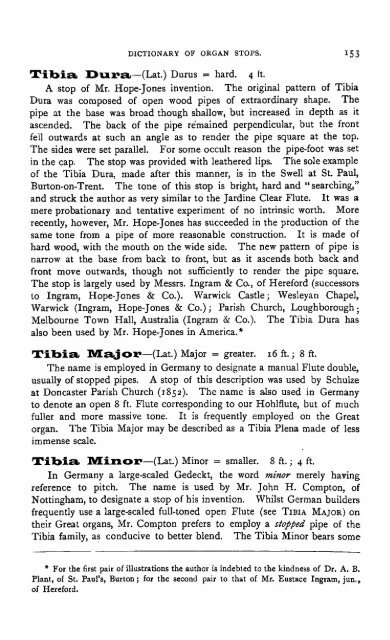A comprehensive dictionary of organ stops - Allen Organ Studio of ...
A comprehensive dictionary of organ stops - Allen Organ Studio of ...
A comprehensive dictionary of organ stops - Allen Organ Studio of ...
You also want an ePaper? Increase the reach of your titles
YUMPU automatically turns print PDFs into web optimized ePapers that Google loves.
DICTIONARY OF ORGAN STOPS. 153<br />
Tibia, Dura— (Lat.) Durus = hard. 4 ft.<br />
A stop <strong>of</strong> Mr. Hope-Jones invention. The original pattern <strong>of</strong> Tibia<br />
Dura was composed <strong>of</strong> open wood pipes <strong>of</strong> extraordinary shape. The<br />
pipe at the base was broad though shallow, but increased in depth as it<br />
ascended. The back <strong>of</strong> the pipe remained perpendicular, but the front<br />
fell outwards at such an angle as to render the pipe square at the top.<br />
The sides were set parallel. For some occult reason the pipe-foot was set<br />
in the cap. The stop was provided with leathered lips. The sole example<br />
<strong>of</strong> the Tibia Dura, made after this manner, is in the Swell at St. Paul,<br />
Burton-on-Trent. The tone <strong>of</strong> this stop is bright, hard and " searching,"<br />
and struck the author as very similar to the Jardine Clear Flute. It was a<br />
mere probationary and tentative experiment <strong>of</strong> no intrinsic worth. More<br />
recently, however, Mr. Hope-Jones has succeeded in the production <strong>of</strong> the<br />
same tone from a pipe <strong>of</strong> more reasonable construction. It is made <strong>of</strong><br />
hard wood, with the mouth on the wide side. The new pattern <strong>of</strong> pipe is<br />
narrow at the base from back to front, but as it ascends both back and<br />
front move outwards, though not sufficiently to render the pipe square.<br />
The stop is largely used by Messrs. Ingram & Co., <strong>of</strong> Hereford (successors<br />
to Ingram, Hope-Jones & Co.). Warwick Castle; Wesleyan Chapel,<br />
Warwick (Ingram, Hope-Jones & Co.); Parish Church, Loughborough;<br />
Melbourne Town Hall, Australia (Ingram & Co.). The Tibia Dura has<br />
also been used by Mr. Hope-Jones in America.*<br />
Tibia Major—(Lat.) Major = greater. 16 ft.; 8 ft.<br />
The name is employed in Germany to designate a manual Flute double,<br />
usually <strong>of</strong> stopped pipes. A stop <strong>of</strong> this description was used by Schulze<br />
at Doncaster Parish Church (1852). The name is also used in Germany<br />
to denote an open 8 ft. Flute corresponding to our Hohlflute, but <strong>of</strong> much<br />
fuller and more massive tone. It is frequently employed on the Great<br />
<strong>organ</strong>. The Tibia Major may be described as a Tibia Plena made <strong>of</strong> less<br />
immense scale.<br />
Tibia Minor—(Lat.) Minor = smaller. 8 ft. ; 4 ft.<br />
In Germany a large-scaled Gedeckt, the word minor merely having<br />
reference to pitch. The name is used by Mr. John H. Compton, <strong>of</strong><br />
Nottingham, to designate a stop <strong>of</strong> his invention. Whilst German builders<br />
frequently use a large-scaled full-toned open Flute (see Tibia Major) on<br />
their Great <strong>organ</strong>s, Mr. Compton prefers to employ a stopped pipe <strong>of</strong> the<br />
Tibia family, as conducive to better blend. The Tibia Minor bears some<br />
* For the first pair <strong>of</strong> illustrations the author is indebted to the kindness <strong>of</strong> Dr. A. B.<br />
Plant, <strong>of</strong> St. Paul's, Burton; for the second pair to that <strong>of</strong> Mr. Eustace Ingram, jun.,<br />
<strong>of</strong> Hereford.


